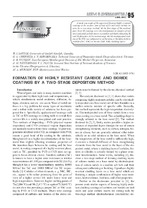Formation of highly resistant carbide and boride coatings by a two-stage deposition method
| dc.contributor.author | Sawich, W. I. | en |
| dc.contributor.author | Cherneta, O. G. | en |
| dc.contributor.author | Korobochka, A. N. | en |
| dc.contributor.author | Sychkov, A. B. | en |
| dc.contributor.author | Nesterenko, A. M. | en |
| dc.contributor.author | Pliuta, V. L. | en |
| dc.contributor.author | Murikov, M. A. | en |
| dc.coverage.spatial | Минск | ru |
| dc.date.accessioned | 2014-07-02T07:47:56Z | |
| dc.date.available | 2014-07-02T07:47:56Z | |
| dc.date.issued | 2011 | |
| dc.identifier.citation | Formation of highly resistant carbide and boride coatings by a two-stage deposition method / W. I. Sawich [et al.] // Литье и металлургия. – 2011. – № 2 (60). – С. 95 - 100. | ru |
| dc.identifier.uri | https://rep.bntu.by/handle/data/8548 | |
| dc.description.abstract | A study was made of the aspects of forming highly resistant coatings in the surface zone of tool steels and solid carbide inserts by a two-stage method. At the first stage of the method, pure Ta or Nb coatings were electrodeposited on samples of tool steel and solid carbide insert in a molten salt bath containing Ta and Nb fluorides. At the second stage, the electrodeposited coating of Ta (Nb) was subjected to carburizing or boriding to form carbide (TaC, NbC) or boride (TaB, NbB) cladding layers. | en |
| dc.language.iso | en/EN | en |
| dc.publisher | БНТУ | ru |
| dc.title | Formation of highly resistant carbide and boride coatings by a two-stage deposition method | en |
| dc.type | Article | ru |
| dc.identifier.udc | 621.9.025 (076) | ru |
| dc.relation.journal | Литье и металлургия | ru |
Files in this item
This item appears in the following Collection(s)
-
№2 (60)[32]

